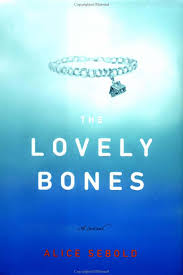
This is a book with too much realism… and not enough of it.
That went through my head right after I’d read through the first half of The Lovely Bones
My name is Salmon, like the fish; first name, Susie. I was fourteen when I was murdered on December 6, 1973.
That’s the start of the novel. Talk about a first sentence that yanks you in by the throat.
The book is told from the point of view of a girl who, after her rape and murder by a man from her neighborhood, goes to heaven. Or what could be heaven, if it wasn’t a perfect world in which she’s trapped, watching as her family tries to pick up the pieces and as her murderer lives out his mundane facade. As life goes on, which it is wont to do, though not always as it should be.
While Susie’s father does suspect the correct person, there’s no evidence to back up this intuition. Susie’s killer, Mr. Harvey, has murdered half a dozen girls already, and he was careful. Here’s where the book is most realistic, by the way. Mr Harvey accosts Susie alone, at night, and picks the correct time – just before a snowfall that destroys any traces the police dogs might have found. Later he dismembers her body, puts the remains in a safe and dumps that into a sinkhole.
After the house changed hands, the new owners tsk-tsked at the dark spot on the floor of their garage. As she brought prospective buyers through, the realtor said it was an oil stain, but it was me, seeping out of the bag.
All that remains is a fallen elbow-joint (which the police later find). I kept hoping the sinkhole would be drained and the remains found, but they never are. Again, that’s very true to life. And Susie’s father doesn’t deliver dramatic vigilante justice. The one time he does come close to using physical violence on another person, the attempt backfires with disastrous results.
The rest of Susie’s family changes as well. Her younger sister closes off, forcing herself to toughen up both mentally and physically (very plausible). Her mother, a housewife already unhappy with her marriage, has an affair with the detective in charge of the investigation (less plausible). Meanwhile, Susie is adapting to her heaven – while also realizing that she won’t grow up and will miss out on so much in life.
The problems began here, since a protagonist who can’t really do anything isn’t going to be very gripping – and a murder mystery that will never really be solved is probably not going to help. Susie is a precocious and sympathetic character, but she has no flaws and no obstacles to overcome in her heaven.
There is a chapter towards the end that seems to have been included to compensate for this, where Susie falls back to earth, possesses the body of another girl and has sex with the boy who gave her her first kiss. It’s a bit like Ray Bradbury’s “The April Witch”, but the characters in that story ring true. In this chapter, I didn’t buy it.
And Susie’s heaven, while clearly meant to be a beautiful and welcoming place with fields of flowers, gazebos, music, friendly dogs, etc. was a little like a Thomas Kinkade painting. Attractive scenery, but there’s not much depth or events of consequence. There are hints that there’s more to eternity than a pretty, perfect world, but I don’t recall anything more than these hints.
After the second half of the book I started skimming. Sebold’s style is much like Susie’s heaven; it’s sweet and flowery to compensate for the fact that very little is happening. There’s a lot of symbolism, much of it to do with the ocean – and the salmon is the fish that has a long journey before it finally reaches its home, and dies. So I’m pleased that I read this book… but I can’t see myself reading it again.









 Especially since I’m also on the first round of edits for the manuscript Samhain Publishing accepted. But I did manage to get around 4000 words of the new novel done, and I’ll keep writing.
Especially since I’m also on the first round of edits for the manuscript Samhain Publishing accepted. But I did manage to get around 4000 words of the new novel done, and I’ll keep writing. 


 Got to write more!
Got to write more!
